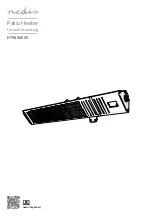
19
EN
Installing the FrostControl (safety/drain valve)
The FrostControl must be installed in the immediate vicinity
of the appliance in the heated room in a location that is easily
accessible to the user. Make sure that rotary switch (30) and
pushbutton (31) can still be operated.
When selecting a location, please ensure that the
FrostControl (24) is not installed in the vicinity of external
heat sources (e.g. power supplies) or in the immediate prox-
imity of warm air ducts.
Water removal can take place directly to the outside in a
splash-protected location (fit splash guards if necessary).
Drill a hole (18 mm diameter) in the floor of the vehicle. Attach
the hose (24b) to the drainage socket (24a), insert both through
the vehicle floor and route to the outside so that they slope
downwards continuously. Align the drainage socket centrally
to the hole. Secure the FrostControl with two B 5.5 x 25 screws
(included with delivery) without tension. Screw in the screws
vertically. Seal gap between hose and hole with plastic body
sealant from below. (See figure 16 – Example of an installation
with flexible hoses Ø 10 mm).
30
25
23
31
31
24b
24
24a
Figure 16
Installing the safety/drain valve
Fit safety/drain valve (24) in easily accessible location in the
vicinity of the appliance. Ensure that the lever can still be
operated.
Water removal can take place directly to the outside in a
splash-protected location (fit splash guards if necessary).
Drill a hole (18 mm diameter) in the floor of the vehicle. At-
tach the hose (24b) to the drainage socket (24a), insert both
through the vehicle floor and route to the outside so that they
slope downwards continuously. Secure the safety/drain valve
in place with 2 screws. (See figure 17 – Example of an instal-
lation with fixed duct routing Ø 12 mm.)
Ø 18 mm
24
24b
25
23
24a
Figure 17
Water pipe connection / routing
In order to ensure that the connected components will work,
the water pipes must be kept as short as possible, and free of
kinks and tension.
Route all water lines so they slope downwards to the
safety/drain valve.
No claims may be made under the
warranty for damage caused by frost.
If a water supply is being installed in the vehicle, it must be
ensured that sufficient room is left between the water lines
and the heat source (e.g. heater, warm air duct).
A water pipe may only be routed at a distance of 1.5 m from
the heater at the warm air duct. The Truma SC hose clip (part
no.: 40712-01) can be used for other distances. With parallel
routing (e.g. through a wall) a spacer (e.g. insulation) must be
fitted in order to avoid contact.
Ensure that the cold water supply does not come into
contact with cold bridges (e.g. the outer wall) in order to
prevent freezing.
Connect cold water supply (23) to safety/drain valve (24).
The included elbow fittings (27 + 28) must always be
used in order to completely empty all water and prevent
the water hoses on the appliance from leaking over time.
Install a water pipe (25) for the cold water supply between the
safety/drain valve (24) and the boiler inlet.
Route the hot water pipe (26) from the elbow fitting with inte-
grated aeration valve (28) to the water consumption points.
Attach elbow fitting (28 – with aeration valve) to upper con-
nection (hot water outlet) and elbow fitting (27) to lower
connection (cold water supply) of heater as far as it will go.
Pull in opposite direction to ensure that the elbow fittings are
securely attached.
Slide venting hose with an outer diameter of 11 mm (29) onto
the hose nozzle of the aeration valve (32) and route to the out-
side free of kinks. Radius of arc must not be less than 40 mm.
Cut off the venting hose about 20 mm below the vehicle floor
at a 45° angle relative to the direction of travel. (See figure 18 –
Example of an installation with flexible hoses Ø 10 mm).
45º
20 mm
32
27
28
29
26
25
Figure 18
















































